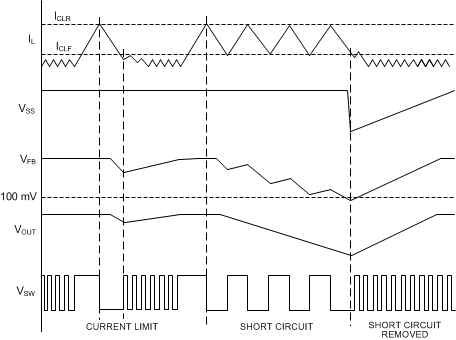JAJSBH3D March 2011 – May 2019 LM21215A
PRODUCTION DATA.
- 1 特長
- 2 アプリケーション
- 3 概要
- 4 改訂履歴
- 5 Pin Configuration and Functions
- 6 Specifications
- 7 Detailed Description
- 8 Application and Implementation
- 9 Power Supply Recommendations
- 10Layout
- 11概要(続き)
- 12デバイスおよびドキュメントのサポート
- 13メカニカル、パッケージ、および注文情報
パッケージ・オプション
メカニカル・データ(パッケージ|ピン)
- PWP|20
サーマルパッド・メカニカル・データ
- PWP|20
発注情報
7.3.6 Current Limit
The LM21215A has overcurrent protection to avoid excessive current levels through the power MOSFETs and inductor. A current limit condition exists when the high-side MOSFET's current exceeds the rising current limit level, ICLR. The control circuitry responds to this event by turning off the high-side MOSFET and turning on the low-side MOSFET. This forces a negative voltage on the inductor, thereby causing the inductor current to decrease. The high-side MOSFET does not conduct again until the lower current limit level, ICLF, is sensed on the low-side MOSFET. At this point, the LM21215A resumes normal switching.
A current limit condition causes the internal soft-start voltage to ramp downward. After the internal soft-start ramps below the feedback (FB) voltage, nominally 0.6 V, FB begins to ramp downward, as well. This voltage foldback limits the power consumption in the device during a sustained overload. After the current limit condition is cleared, the internal soft-start voltage ramps up again. Figure 26 describes current limit behavior including VSS, VFB, VOUT and VSW waveforms.
 Figure 26. Current Limit Conditions
Figure 26. Current Limit Conditions